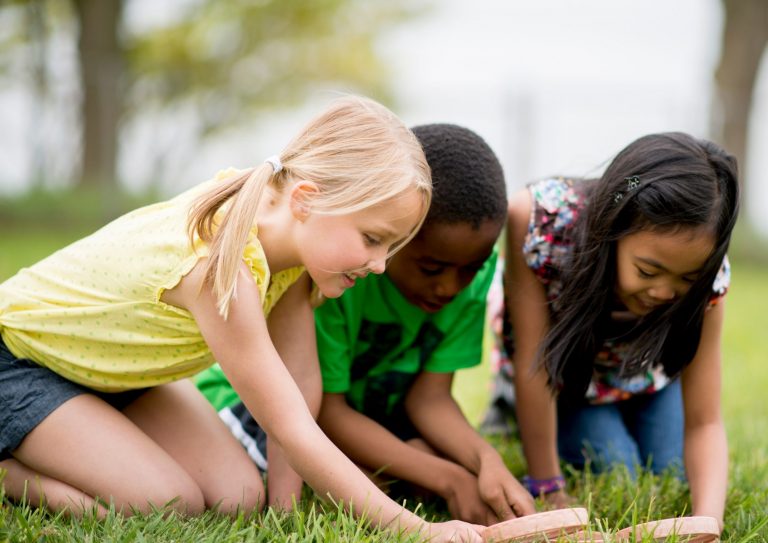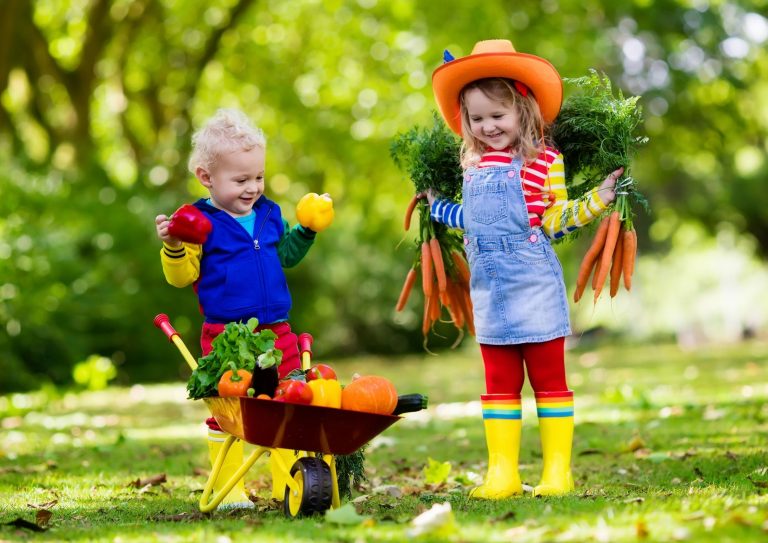An outdoor sensory garden helps in engaging and stimulating the five basic senses of taste, touch, sound, smell, and sight. Sensory gardens are great for children as it encourages them to tap into the principles of mindfulness by connecting to nature and allowing them to be more aware of their surroundings. Spending time in an outdoor sensory garden can calm your child’s mind, enhance their sense of wellbeing, and reduce stress.
In this article, we will share some useful sensory garden ideas that you can use when creating a sensory garden for your kids.

What is a Sensory Garden?
A sensory garden is designed to have the maximum sensory impact on children. It can be presented as a whole, themed, or divided into sections. Sensory gardens are welcoming and encourage children to listen, admire, taste, and touch. Creating a sensory garden is a rewarding and exciting adventure that offers numerous opportunities to exercise and teach horticultural healing therapy techniques to kids.
Tips For Creating an Outdoor Sensory Garden
There are various outdoor sensory garden ideas that can be tailored to your garden objective. For example, if the primary objective of the garden is to educate children, it might be a good idea to keep plant heights within reach and utilize small spaces. Other useful outdoor sensory garden ideas include incorporating hardscape elements like garden art, bird feeders, water fountains, paths, and benches to maximize the sensory impact.
Your outdoor sensory garden’s design may be a multi-sensory mixture, thematic, or laid out to stimulate different senses at a time. You can divide the garden into separate sense zones such as taste, sight, or smell. Alternatively, you can blend different elements to engage multiple senses simultaneously.
Taste
Stimulate your children’s taste buds with fresh vegetables, fruits, and herbs. From strawberries, blackberries, and apples, to tomatoes, carrots, and chili peppers, there are plenty of vegetables and fruits to use in the “taste” garden. Herbs such as parsley, mint, coriander, and basil are tasty treats to incorporate. To add to the taste variety, you can also include some edible flowers.
Sight
Sight is an effective method for stimulating your children’s senses in the outdoor garden. Create a sensory feast of diverse plant patterns, texture, size, shape, and color. A good place to start would be bold and bright flowers, such as alliums, tulips, pelargoniums, and purple cornflower. You can also incorporate native wildflowers, such as corn marigold, ragged robin, ox-eye daisy, and common poppies. Colorful wildflowers attract butterflies and pollinating bees, adding an extra visual dimension and movement to your garden.
A variety of patterns, hues, shapes, heights, and architecture can be created using different species of shrubs, trees, and other plants. Ornamental grasses, such as architectural seed heads, and pampas grasses can add interesting movement and structure. To add some sensory drama to the display, incorporate leaves with striking natural designs. Some eye-catching examples include plantain lily, fan plant, and Persian shield.
Spice up the presentation by selecting miniature, straight standing, hanging, or creeping plant species. To make the outdoor sensory garden more lively, incorporate a water feature. A birdbath, pond, or even a fountain will add contrasting texture and fluidity, create beautiful texture, and attract a variety of beautiful birds and wildlife. Having a seating area or bench in the garden can provide children with the perfect opportunity to relax while admiring the natural surroundings.


Smell
Beautiful floral fragrances, freshly cut grass, and earthy aromas are great ideas for stimulating children’s sense of smell. Improve their sensory experience with a mix of various aromatic plants such as sage, mint, rosemary, lavender, jasmine, honeysuckle, and strong-scented roses. Deliciously scented herbs are also a great addition since they stimulate your children’s taste sense and are multi-sensory.
Sound
Incorporating elements that create contrasting sounds is a great idea for your outdoor sensory garden. The trickling sound of a fountain or waterfall in your garden can be helpful in stimulating children’s hearing. The wind rustling through the grasses, bamboo stems, plant foliage, and leaves on trees will create contrasting sounds as they move with the breeze. Native wildflowers attract wildlife such as insect pollinators and buzzing bees which can create beautiful sounds for your outdoor sensory garden.
Keep birds present and happy in the garden by incorporating a feeder and birdbath. The beautiful and musical sound of birds will be a welcome addition to your aural landscape. You can also incorporate some large or small stones, or crunchy gravel into your outdoor garden. The hard elements of the stones will add contrasting sounds to softer elements as children walk around the garden.
Touch
Incorporating different textures and surfaces in your garden is an excellent way to enhance sensory delight for your children’s touch. Add contrasting materials that are fluid, solid, rough, smooth, soft, or hard. The smooth surface of succulents, soft furry leaves of Stachys Byzantina, and feathery and plumped ornamental grasses are all southing and lovely to touch. Spongy mosses, rough seed pods, and tree bark feature a variety of exciting textures.
Another fun way to add texture is to incorporate rough natural stone boulders, and smooth pebbles to circle a pond or mark out a pathway. Sculptures, walls, and other structures made from metal, glass, brick, or stone can create a delightful textural element for stimulating your children’s touch experience. Water features are excellent additions for stimulating your children’s touch. The feel of fluid water flowing over your children’s hands as they explore the garden offers a very refreshing contrast.


Final Words
A flourishing outdoor sensory garden allows your children to notice the effect of their senses, tune in to their surroundings, and connect with nature. To help your children as they begin this exciting journey, try this quick method. Ask them to take a deep breath and focus on one thing they can taste, two things they can smell, three things they can hear, four things they can touch, and five things they can see. This multi-sensory exercise can stimulate your children’s senses and help them focus and calm their minds, with the outdoor sensory garden providing the ideal soothing escape they need.
Related Posts
-
How to Create a Children's Sensory Garden
Gardens are, by their very nature, a wonderfully sensory experience. Even the simplest…
-
Sensory Gardens for Schools – How Everyone Can Benefit!
Boost your child's engagement in learning and love for nature by implementing a sensory garden…
-
How to Create a Butterfly Garden for Kids
Imagine a visual of your garden where you see a group of colourful butterflies gracefully…



